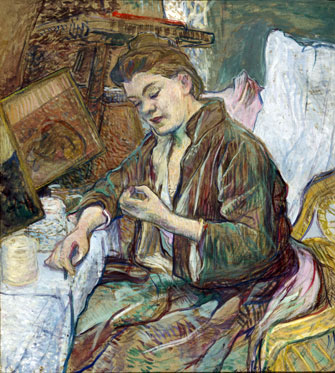Tracing the Origins of
Modernity in Art

“Canotiers à Argenteuil” (1874) by Claude Monet. David and Ezra Nahmad Collection.
Anyone vacationing in the South of France this summer would do well to visit the pretty port town of Sète and, while there, to stop in at the Musée Paul Valéry to see its current show featuring rarely exhibited works from the collection of two wealthy art dealers and collectors, the brothers David and Ezra Nahmad.
The idea of this selection of some 70 works is to show how one artistic movement leads to another, illustrated by paintings from major European artistic movements, beginning around 1850, that marked the break with the Academy and the stirring of modernity, and continuing through the turn of the 20th century.
The show starts off with a bang with a roomful of works by Barbizon School painter Camille Corot (1796-1875) that show him “on the road to Impressionism,” as Maithé Vallès-Bled, museum director and exhibition curator, puts it, and by Gustave Courbet (1819-77).
Corot’s role as a forerunner of Impressionism can be most clearly seen in the dabbed-on brushstrokes and treatment of light in two lovely small paintings. “A Etretat, Femme et Enfant au Bord de la Mer” (1865) shows a well-wrapped woman who seems to be reading sitting on the beach next to a naked child playing in the sand against the backdrop of a yellow-tinted sea and sky. There is something very touching about this painting with its simple, abstracted forms. In the other one, “Femme Agenouillé Cueillant des Pissenlits (c. 1865), the woman kneeling in the grass picking dandelions forms a triangular shape, echoing the form of the two figures on the beach in the other painting.
The show also includes a number of light-filled paintings by another pre-Impressionist, Monet’s mentor Eugène Boudin (1824-98), including one of his marvelous depictions of stormy sea and sky, “Deauville, le Rivage par Gros Temps” (1890). Then we arrive at full-fledged Impressionism with works by Alfred Sisley (1839-99), Camille Pissarro (1830-1903) and Monet himself, represented by a number of beautiful works, among them a shimmering, richly colored view of the Ducal Palace in Venice dating from 1908.
There are no fewer than nine paintings by Auguste Renoir in the show, and, although I am usually put off by his often garish and saccharine paintings of women and girls, I appreciated the subtle and nearly color-free “Liseuse” (1877), a dark, moody depiction of a woman dressed in black sitting in an armchair reading. Practically the only color in this piece is the pink on the flesh of her face and hands.
The show then touches on the work of the Pont-Aven School (Emile Bernard and Paul Sérusier), the Nabis (with a number of dissimilar works by Pierre Bonnard and a few by Edouard Vuillard) and naïve painting (Douanier Rousseau, of course).
Among the Postimpressionist works are two appealing portraits of women by Henri de Toulouse-Lautrec, “Femme Rousse Assise

“La Toilette: Mme Fabre” (1891) by Henri de Toulouse-Lautrec. Collection David and Ezra Nahmad.
dans le Jardin du Père Forest” (1899) and “La Toilette: Madame Fabre (Femme se Faisant le Mains)” (1891).
The exhibition ends with Symbolist works by Gustave Moreau and Odilon Redon. While I have never developed a taste for this movement, I was intrigued by Moreau’s version of “Suzanne et les Vieillards” (1895), in which Suzanne is lavishly draped with bejeweled garments that don’t do much to hide her nakedness, while the faces of the elders spying on her from the next room can barely be seen in the dark shadows.
The museum, in a handsome modern building (recently renovated) on the Mont Saint Clair hillside above Sète’s sailors’ cemetery, has a view of the sparkling waters of the Mediterranean and a shady outdoor restaurant-café, a great spot for a meal or a drink.
Named after an illustrious native son of Sète, Paul Valéry (1871-1945), it has a display devoted to the poet’s life and work as well as a collection of artworks dating from the 19th century to the present by such artists as Raoul Dufy, Toussaint Rousy and Albert Marquet. Local artists associated with the Groupe Montpellier-Sète and the Figuration Libre movement are also represented. One of the latter, Hervé Di Rosa, was the founder of a gallery in town, the Musée International des Arts Modestes, currently holding “Manila Vice” (through September 22), an exuberant exhibition of works by contemporary Filipino artists.
Musée Paul Valéry: 148; rue François Desnoyer; 34200 Sète. Tel.: 04 99 04 76 16. Through October 27. Open daily 9:30am-7pm. Admission: €7. www.museepaulvalery-sete.fr
Musée International des Arts Modestes: 23, quai Maréchal de Lattre de Tassigny, 34200 Sète. Tel.: 04 99 04 76 44. Open daily April 1-September 30, 9:30am-7pm; October 1-March 31, 10am-noon and 2pm-6pm. Closed January 1, May 1, November 1 and December 25. Admission: €5. www.miam.org
Click here to read all of this week’s new articles on the Paris Update home page.
Reader Reaction: Click here to respond to this article (your response may be published on this page and is subject to editing).
Click here for more C’est Ironique! columns.
Support Paris Update by ordering books from Paris Update’s Amazon store at no extra cost. Click on your preferred Amazon location: U.K., France, U.S.
© 2013 Paris Update”
Favorite